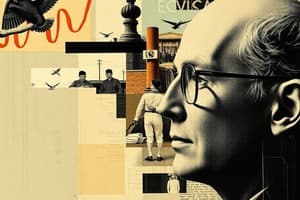Podcast
Questions and Answers
What are the key sectors contributing to India's economy?
What are the key sectors contributing to India's economy?
Key sectors include agriculture, manufacturing, services (such as IT), and renewable energy.
What major economic challenges does India face despite its growth?
What major economic challenges does India face despite its growth?
India faces challenges such as poverty, income inequality, infrastructure development gaps, and high unemployment.
How does India's large population impact its economy?
How does India's large population impact its economy?
A large population affects economic resources and development, creating both challenges and opportunities for labor force expansion.
What have been the key focuses of economic reforms in India?
What have been the key focuses of economic reforms in India?
What are some challenges faced by the agricultural sector in India?
What are some challenges faced by the agricultural sector in India?
How has the manufacturing sector in India evolved in recent years?
How has the manufacturing sector in India evolved in recent years?
What role does the Indian government play in the economy?
What role does the Indian government play in the economy?
How does foreign trade influence the Indian economy?
How does foreign trade influence the Indian economy?
What are the key principles of Classical Economics?
What are the key principles of Classical Economics?
How does Keynesian Economics view the role of government in the economy?
How does Keynesian Economics view the role of government in the economy?
What is the main focus of Monetarism in economic theory?
What is the main focus of Monetarism in economic theory?
Explain the concept of surplus value in Marxist Economics.
Explain the concept of surplus value in Marxist Economics.
What insights does Behavioral Economics provide into economic decision making?
What insights does Behavioral Economics provide into economic decision making?
What is the primary belief of Supply-Side Economics regarding economic growth?
What is the primary belief of Supply-Side Economics regarding economic growth?
Describe the nature of India's economy as a mixed economy.
Describe the nature of India's economy as a mixed economy.
Which economic theory argues that markets may not always be self-correcting?
Which economic theory argues that markets may not always be self-correcting?
Flashcards
Classical Economics
Classical Economics
An economic theory emphasizing free markets, minimal government intervention, and the economy's self-regulating ability to reach full employment.
Keynesian Economics
Keynesian Economics
An economic theory promoting government intervention to manage aggregate demand and stimulate economic growth, particularly during recessions.
Monetarism
Monetarism
Economic theory that emphasizes the crucial role of money supply in controlling inflation and output fluctuations.
Marxist Economics
Marxist Economics
Signup and view all the flashcards
Behavioral Economics
Behavioral Economics
Signup and view all the flashcards
Supply-Side Economics
Supply-Side Economics
Signup and view all the flashcards
Mixed Economy
Mixed Economy
Signup and view all the flashcards
Key Sectors of Indian Economy
Key Sectors of Indian Economy
Signup and view all the flashcards
Indian Economic Challenges
Indian Economic Challenges
Signup and view all the flashcards
Indian Population Impact
Indian Population Impact
Signup and view all the flashcards
Economic Reforms in India
Economic Reforms in India
Signup and view all the flashcards
Agricultural Sector Challenges (India)
Agricultural Sector Challenges (India)
Signup and view all the flashcards
Manufacturing Sector Growth (India)
Manufacturing Sector Growth (India)
Signup and view all the flashcards
Service Sector (India)
Service Sector (India)
Signup and view all the flashcards
Government Role in Indian Economy
Government Role in Indian Economy
Signup and view all the flashcards
Foreign Trade Impact (India)
Foreign Trade Impact (India)
Signup and view all the flashcards
Financial Markets (India)
Financial Markets (India)
Signup and view all the flashcards
Study Notes
Economic Theories
-
Classical Economics: A school of thought emphasizing free markets, limited government intervention, and the self-regulating nature of the economy. Key figures include Adam Smith, David Ricardo, and Thomas Malthus. Classical economists believed in laissez-faire policies and saw the economy as naturally tending towards full employment, driven by supply and demand.
-
Keynesian Economics: Developed by John Maynard Keynes during the Great Depression, this theory emphasizes the role of government intervention in managing aggregate demand to stimulate economic growth, especially during recessions. It argues that markets are not always self-correcting and that government spending and taxation can stabilize the economy.
-
Monetarism: A macroeconomic theory emphasizing the role of money and credit in the economy. Monetarists, like Milton Friedman, believe that changes in the money supply are the primary driver of inflation and fluctuations in aggregate output. They advocate for stable monetary policies to control inflation and support macroeconomic stability.
-
Marxist Economics: A critique of capitalism, arguing that it is inherently exploitative and prone to crises. Central to Marxist theory is the concept of surplus value, where capitalists extract profit from the labor of workers. Marx predicted that capitalism would inevitably collapse due to internal contradictions.
-
Behavioral Economics: Combines insights from economics with psychology to understand how people actually make economic decisions. It recognizes that people are not always rational and that their choices are influenced by cognitive biases and emotions. This approach provides a more nuanced understanding of economic behavior and market outcomes.
-
Supply-Side Economics: Focuses on increasing the supply of goods and services to stimulate economic growth. This approach emphasizes factors like tax cuts, deregulation, and investment incentives to boost productivity and output, believing that lower taxes lead to increased incentives for businesses to invest and create jobs.
Indian Economy - Overview
-
Mixed Economy: India's economy is a mixed economy, incorporating elements of both a market-oriented approach and significant government intervention. This involves both private initiatives and substantial public sector activity.
-
Key Sectors: Key sectors contributing a significant portion to India's economy include agriculture, manufacturing (including textile and apparel), services (including IT), and more recently, renewable energy and technology.
-
Challenges: While experiencing significant growth, India still faces economic challenges. These encompass issues like poverty, income inequality, and infrastructure development gaps. Unemployment remains a persisting concern, especially for young people.
-
Population: A large and growing population has an impact on economic resources and development challenges. Young demographics present a potential economic benefit through a labor-force expansion, but also require investment in education and opportunities.
-
Economic Reforms: In recent decades, India has undertaken economic reforms aimed at opening markets, attracting foreign investment, and promoting private sector development. These reforms have had varying impacts on different segments of the population and different states.
Indian Economy - Specific Aspects
-
Agricultural Sector: Despite being a part of India's GDP, the agricultural sector, while employing a large segment of the population, has faced challenges in terms of modernization, productivity, and access to resources and credit.
-
Manufacturing Sector: The manufacturing sector has seen growth, with focus on specific sectors like automobiles and pharmaceuticals. However, it faces challenges in terms of technological advancements and competitiveness with other global players.
-
Service Sector: The service sector, including IT, telecom and tourism makes a large contribution to India's GDP. The sector's performance is also influenced by global demand and technological disruptions.
-
Government Role: The Indian government continues to play a significant role in the economy, through policymaking, regulations, and various development programs. The Indian government's influence in infrastructure development, social programs, and providing essential services remains substantial.
-
Foreign Trade: Foreign trade, both imports and exports, is a critical aspect of the Indian economy, influencing growth and access to global markets and vital resources. India is a significant player in global trade, interacting with and dependent on global economic conditions and trends.
-
Financial Markets: The Indian financial sector encompasses various institutions and markets that play essential roles. This covers areas like banking, capital markets, and other financial instruments involved in savings, investment, and risk management. The performance and stability of the financial system are crucial to overall economic health.
Studying That Suits You
Use AI to generate personalized quizzes and flashcards to suit your learning preferences.




